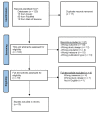Impacts of Skin Color and Hypoxemia on Noninvasive Assessment of Peripheral Blood Oxygen Saturation: A Scoping Review
- PMID: 37900526
- PMCID: PMC10610303
- DOI: 10.7759/cureus.46078
Impacts of Skin Color and Hypoxemia on Noninvasive Assessment of Peripheral Blood Oxygen Saturation: A Scoping Review
Abstract
Standard pulse oximeters estimate arterial blood saturation (SaO2) non-invasively by emitting and detecting light of a specific wavelength through a cutaneous vascular bed, such as a digit or the ear lobe. The quantity measured at these peripheral sites is designated as oxygen saturation (SpO2). Most reliable pulse oximeters are calibrated from measurements of healthy volunteers using some form of oxygen desaturation method. As the degree of inducible hypoxemia is limited, the calibration below achievable desaturation levels is usually extrapolated, leading to potential measurement error at low SaO2 values, especially in highly pigmented skin. Such skin color-related errors (SCRE) are the topic of this scoping review. Specifically, this study aimed to identify the combined impact of skin color and reduced SaO2 on the non-invasive assessment of SpO2 and report the consequences of potential inaccuracies. Three databases were searched (Cumulated Index to Nursing and Allied Health Literature (CINAHL), PubMed, and Web of Science) for peer-reviewed prospective and retrospective studies published in English between 2000 and 2022 involving human patients with hypoxemia that included a measure of skin color (Fitzpatrick scale or race/ethnicity). Ten studies met the criteria and were included in the final review. Eight of these studies reported statistically significant higher pulse oximeter readings in darker-skinned patients with hypoxia compared to their arterial blood gas measurements. Occult hypoxia was more prevalent in Black and Hispanic patients than in White patients. Minority patients overall (Black, Asian, and American Indian) were more likely to have a SaO2 < 88% that was not detected by pulse oximetry (occult hypoxemia) during hospitalization. With greater levels of hypoxemia, the differences between SpO2 and SaO2 were greater. If SaO2 was < 90%, then SpO2 was overestimated in all ethnicities but worse in minorities. In conclusion, the bias found in pulse oximeter readings in the skin of color broadly impacts patients with hypoxemia. The failure of SpO2 measuring devices to detect occult hypoxemia can delay the delivery of life-saving treatment to critically ill patients requiring respiratory rehabilitation and supplemental oxygen therapy. This may lead to adverse health outcomes, increased in-hospital mortality, and complications such as organ dysfunction. An improvement in pulse oximeter detection mechanisms that would include all skin pigmentations is therefore much desired to optimize individual healthcare status and minimize disparities in treatment.
Keywords: electronic monitoring devices; false hypoxemia; occult hypoxia; pulse oximetry; racial bias; racial disparity; skin color; skin pigmentation.
Copyright © 2023, Aoki et al.
Conflict of interest statement
The authors have declared that no competing interests exist.
Figures
References
-
- Pulse oximetry. Tremper KK, Barker SJ. Anesthesiology. 1989;70:98–108. - PubMed
-
- Pulse oximetry: principles and limitations. Sinex JE. Am J Emerg Med. 1999;17:59–67. - PubMed
-
- Pulse oximeters: essential monitors with limitations. Kidd JF, Vickers MD. Br J Anaesth. 1989;62:355–357. - PubMed
-
- Pulse oximetry. Kelleher JF. J Clin Monit. 1989;5:37–62. - PubMed
-
- Accuracy of response of six pulse oximeters to profound hypoxia. Severinghaus JW, Naifeh KH. Anesthesiology. 1987;67:551–558. - PubMed
Publication types
LinkOut - more resources
Full Text Sources
Research Materials
Miscellaneous

